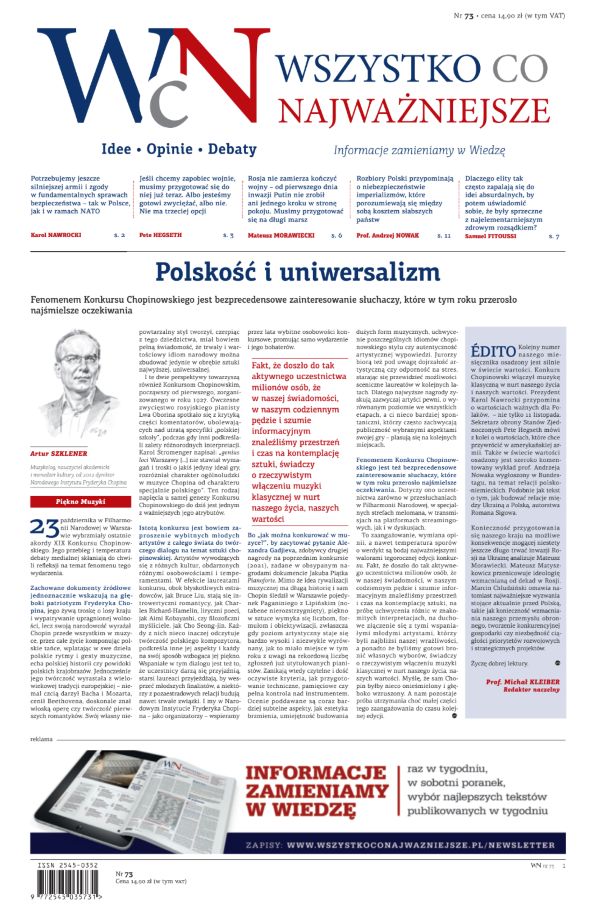 The Chopin Competition will soon turn 100
The Chopin Competition will soon turn 100
How did it all start?
.The beginnings of the International Chopin Competition go back to 1925, when the idea was first proposed by Jerzy Żurawlew, a Polish pianist. It was a novel and surprising concept at the time. As Żurawlew remembered in later years, ‘young people at that time, not long after the end of the Great War, were taking a keen interest in sports. They were dyed-in-the-wool realists in their outlook on life. I would often hear that Chopin was excessively romantic, that he enervated the soul and weakened the psyche. Some went so far as to discourage the inclusion of Chopin as required repertoire in music schools. All that showed a fundamental lack of understanding, which I found very painful… As I watched young people’s enthusiasm for sporting achievement, I finally hit upon a solution: a competition! Here was a format to bring tangible advantages to young performers of Chopin in the form of monetary prizes and an international performing career.’
The next International Chopin Competition will take place in 2025, coinciding with the centenary of Żurawlew’s proposal. By that time the competition will have gathered even more status and influence, providing a fitting opportunity to revisit the person behind the original idea.

.Jerzy Żurawlew was born to a landowning family in Rostov-on-Don (Russia) in 1886/1887. The son of a Russian father and a Polish mother, he began taking piano lessons at the age of five thanks to the encouragement of his mother, herself an able pianist. Just three years later he was performing for Ignacy Jan Paderewski. His encounter with the celebrated maestro and his consistent artistic development in later years would take him all the way to the Warsaw Conservatory, where he studied under Aleksander Michałowski, the most celebrated Chopin teacher of the day. A pianist, but also a promising painter and sculptor, Żurawlew was spoiled for choice as a high school graduate. He chose to focus on music, and treated his other artistic pursuits as hobbies. His pianistic skills and excellent organising talents carried the promise of a great career, and he was discovered early. He made his debut at the Warsaw Philharmonic as a student in 1910, performing the Concerto in E flat major by Ferenc Liszt. The Warsaw daily newspaper Kurier Warszawski wrote: ‘Despite failing to attract a large audience, yesterday’s concert had a beautiful programme and excellent performers, particularly a pianist of genius, who made a sensation with his extraordinary virtuosic artistry. This was Mr. Żurawlew, disciple of Michałowski and a graduate of the local Conservatory…’
Soon afterwards the young Żurawlew moved to the city of Minsk, where he would set up a music conservatory. The following year he was forced to abandon the project as he fled from the Russian Empire in the wake of the Communist revolution in 1917. His role in establishing the Conservatory, which continues to operate in Belarus, remains a little-known episode in his life. After returning to Warsaw, he taught piano at the Chopin School of Music run by the Warsaw Music Society. Teaching became the main focus of his career, punctuated by successful public performances.
The newly conceived Chopin Competition became a true test for Jerzy Żurawlew’s organising skills, as he faced years of indifference, lack of belief and even active resistance, an experience that left lasting memories. However, he managed to secure the support of musicians associated with the Warsaw Music Society and the generous assistance of influential friends, including the famous writer Juliusz Kaden-Bandrowski. His breakthrough came after a meeting with President Ignacy Mościcki, who lent his support to the project, funded one of the prizes and helped him overcome many obstacles.
As we reflect with pride on the status of the International Chopin Competition today, we should remember the people who first helped to put it on the map. They would have been thrilled to see the lasting success of their efforts, which has far outstripped their original ambitions. Unwittingly, they also opened a debate, now almost a century old, on the nature of a ‘Chopin style’.
The Chopin Style
.When the first Chopin Competition was inaugurated in Warsaw, the concept of a ‘Chopin style’ had not yet been defined, even if the composition of the first jury gave a clear indication of the general idea. Jerzy Żurawlew, the initiator of the Chopin Competitions, wrote: ‘Given that Chopin was a Pole and wrote quintessentially Polish music, our idea was to assemble an all-Polish panel of jurors who would be best placed to evaluate the performances.’ However, the results of the first Competition, in 1927, quickly put that sense of national self-assurance to the test: the winner was Lev Oborin, a Soviet pianist. In the words of Jarosław Iwaszkiewicz, an up-and-coming writer and poet who would later become a major literary figure in Poland, ‘The piano continues to reign supreme in the East. We can surmise this from the Warsaw appearances of four phenomenal Russians who brought with them the old piano traditions dressed in a fresh, youthful and dazzling costume; their performances were entirely free of the theories now current in the West and favoured by their émigré compatriots, such as Prokofiev or Borovsky, with their “dry” and “rhythmical” elements. The victorious Russians owed their dazzling success to the fact that they played Chopin the way Chopin should be played. Simply put, they had a grasp of the style.’
Five years later the second Competition had an international panel of jurors, but the definition of a Chopin style remained stubbornly elusive. Music critic Karol Stromenger concisely summarised the problem: ‘We all know the joke about the store plastered with notices: “English spoken here”, “Si parla italiano”, “Se habla español”, etc. A customer enters and asks a series of questions in those languages, but the staff always reply in Polish. Finally he asks: “Tell me, who speaks all those foreign languages?” Their reply: “Customers do!” In the same way an international participant in the Chopin Competition might initially be looking for some Chopin tradition that is specific to Warsaw – but as the Competition progresses it dawns on him that the true heights of Chopin performance are to be found in Russia, Hungary or Belgium, and not in Warsaw specifically. The competition owes its significance to international pianists more than it does to Polish ones. Does that make Chopin’s music cosmopolitan [i.e. unmoored from Polishness]? By no means – it is unarguably Polish, but not in a way that makes it the exclusive preserve of Polish pianists. This is a pressing problem, and it invites us to re-examine our concepts… To overlook the fact that foreign musicians now play Chopin better than Poles do, and that they are pointing the way towards a less monumental interpretation of his music, would be to bury our heads in the sand.’
The problem of formulating a concept of a Chopin style persistently plagued the Polish organizers of the Competition. It was not until five competitions later that Zbigniew Drzewiecki, a celebrated teacher and a juror himself, offered an audacious conclusion: ‘Any attempt at formulating a set of unequivocal scholarly and aesthetic guidelines is doomed to fail. Once we realise this, we can take a different approach to Chopin, and we can try to capture the general characteristics of his music that might offer a key to unlock the correct interpretation of the Chopin text… Pianists who understand Chopin avoid treating his music as a mere pretext for virtuoso display, or suffocating it with sentimentality, or drowning it in lachrymose sappiness. Those pianists understand the role and significance of his polymelodic passages, the importance and fluidity of his accompaniment, the vocality of his grace notes; those pianists know how to respect Chopin’s original interpretation markings and to attune themselves to the mood and atmosphere of his artistic expression. Simplicity and naturalness, the singsong lilt and grace of his phrases and musical ideas, a fluid and restrained use of his tempo rubato – all those things need to be understood deeply and studied with care. Lastly, [pianists] should respect the piano’s technical limitations. They should steer clear of excessively powerful fortissimo passages or, conversely, impressionistic effects that take the form of almost inaudible sound “vapours” or “zephyrs” – just as they should refrain from breakneck tempi that distort the character of a piece’.
Zbigniew Drzewiecki’s conclusions send a clear message to contestants taking part in international piano competitions: strive to understand, not to impress. This is excellent advice, but it is also cryptic. For obvious reasons, Polish pianists in particular have grappled with this problem. For them, the International Chopin Competition has long offered the surest and most coveted way to launch a solo career; after all, participation alone is sufficient to claim a place in the elite ranks of ‘Chopin performers’. The Competition’s elite status is also coupled with a sense of rivalry inherent to a format where participants are pitted against one another in the quest for an ideal performance. So are we now any closer to understanding the qualities that make a great Chopin performer, and how to become one? One thing is certain: At each Competition, these questions are addressed by music critics and audiences alike – and often enough, their conclusions turn out to be in agreement with the decisions of the jury.
Chopinist
.The path to becoming a ‘Chopinist’, a respected Chopin performer, has turned out to be a difficult one. This became abundantly clear after the 2nd Competition, held in 1932. Szymon Waljewski, a professor at the Warsaw Conservatory, wrote at the time: ‘We are seeking the god of truth, and we are failing to find him. He was nowhere to be found among the “Competition” performances of Chopin. What we might call the Chopin spirit or essence has been turned into a testing ground where young virtuosos seek to further their own ambitions. What was originally intended as a Chopin competition is now turning out to be nothing more than a piano competition.’
Similar shortcomings were identified five years later. Michał Kondracki, a composer and music critic, traced the problem to the makeup of the jury. ‘The panel continues to be put together without much thought. As a result, out of the thirty-six jurors [sic!] only a few were Chopin experts, and none of note. There were experts on Liszt, Bach, Beethoven, experts on French music, Hungarian music, even Japanese music – the only thing missing was a true Chopinist. Unsurprisingly in this kind of jury, the focus was firmly on virtuosity… Given its composition, the jury could have hardly done otherwise.’ More recently, laureates of Chopin Competitions have come to dominate the jury, removing any doubt about the panel’s Chopin credentials. However, another problem was identified during the memorable 1937 event, relating to a challenge that continues to be relevant to the competition. As noted by Juliusz Kaden-Bandrowski: ‘Until a collected edition of Chopin’s music can be published, complete with fingerings, commentary and reliable readings developed with the assistance of masterful performers, the task of properly propagating the Chopin tradition will continue to pose difficulties. At present, laureates of the Competition win applause, money and a degree of fame. Oh, for the day when they can also receive, alongside their prizes, an authoritative edition of Chopin’s works that encompasses the pianistic expertise of generations of our best maestros!’
Kaden-Bandrowski would have been aware that just this kind of publishing project was under way at the time, edited by Paderewski. However, that project would take many years before it reached fruition, and even then a new edition based on more reliable sources soon became necessary. A newer, source-based edition would be helmed by Jan Ekier, himself a laureate of the 1937 Competition. Neither edition ever succeeded in imposing a single uniform understanding of Chopin’s music – which is probably for the best. Jerzy Waldorff, a well-known music critic, wrote in 1965: ‘Originally, the people behind the first Chopin Competitions hoped to start a major international debate on the best way to perform Chopin – on how to codify and unify a “Chopin style”, and ideally offer it to the world as “the Polish piano school”. The exact opposite has actually been the case… It seems to me that it is precisely the diversity of Chopin interpretations, rather than a single uniform one, that constitutes his great victory and demonstrates his continued relevance. Though understood differently, his music continues to remain attractive around the globe.’ Written after the first stage of the 1965 Competition, Waldorff’s insight remains as true as ever. He would be proved right, resoundingly, a mere two weeks later, when the main prizes in that Competition went to Martha Argerich, Arthur Moreira Lima and Marta Sosińska.
What is the Polish piano school today? What are its origins? These questions are perhaps best answered by the pianists themselves, but one very apposite observation in particular comes to mind. In 1970, Paweł Beylin, a celebrated lover of music and a sociologist, sounded this warning against insular thinking: ‘The belief that Chopin can be a remedy to major pianistic shortcomings is a delusion. In order to achieve true perfection in performing one composer, one must be able to perform many. Otherwise we are dealing with a kind of transparent deception… We must not allow the likes of Paderewski or Hofmann to be ousted by performer manqués, downtrodden but supposedly authentically Polish, whose legitimacy is based on nothing more than the official music degrees in their pockets.’
.His words of warning bring back chilling memories to people who remember those darker times from half a century ago – but the rest of us can now enjoy a new world, untroubled by the ghosts of the past.
Grzegorz Michalski




